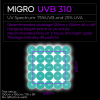@Grow Lights Australia I think I'll answer this one, as this topic has been raised before.
^ This is not true. And I'm going to explain why.
This is the spectral absorption curve of UVR8. It's pretty impressive when you look at the peak around 285nm. It's even more impressive when you look at the inset graph that shows x10 detail of the UVR8 receptor tail.
View attachment 5035117
What does it all mean? It means that yes, UVR8 is most sensitive to light around 285nm. And it has to be. Have a look at a typical sunlight spectral graph. I apologise for the smaller image, but it was the only one I could find that went down below 285nm.
View attachment 5035124
The first thing you notice is how little UVB radiation below 300nm hits the earth – almost none! This is important, because it explains why the UVR8 photoreceptor is so sensitive to UVB light around 285nm – because in nature, there is hardly any light around that wavelength to begin with.
I'm sure we all understand that UVB radiation near the UVC range is VERY damaging to all DNA – including plants. So plants need to detect even small amounts of UVB in order to trigger the production of phenolic compounds to protect their cells against DNA damage.
The thing is, it's not just light around 285nm (short-wave UVB) that is damaging to DNA. All UVB and also UVA light are damaging to DNA. However, long-wave UVB (300+nm) and UVA (310+nm) are much more prevalent – therefore plants do not need to be as sensitive to this light, as there is more of it to trigger a phenolic (secondary metabolite) response.
Let's go back to that first graph now . . . have you noticed that the response curve has an inverse relationship to natural sunlight? That's no coincidence! The UVR8 receptor actually absorbs light as high as 420nm, which is in the violet range. So in fact, even though the absorption curve is most sensitive at around 285nm, the photoreceptor still abosorbs other light. It's just that there is more of that light, and therefore the receptor does not need to be as sensitive to detect it.
And that is why UVA light – even around 400nm – triggers a phenolic response in plants. Cannabis just happens to produce cannabinoids as part of its phenolic response (it also produces non-cannabinoid phenolics to protect itself from light damage).
View attachment 5035117
I will finish this post by stating that you can do a lot of damage to plants by overexposing them to even small amounts of UVB – especially at lower wavelengths. So if you must use UVB, then use it sparingly. BTW, we believe that longer exposure to UVA has the same effect as shorter exposure to UVB – for all the reasons above.










